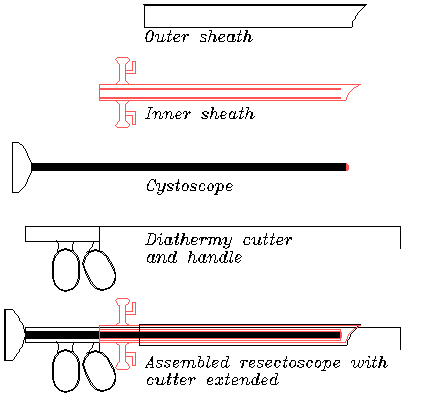An introduction to the prostate and manual prostate surgery
Introduction to the prostate
This is a small gland at the base of the bladder through which the urethra passes. Also entering the prostate is the ejaculatory duct. The prostate's function is to provide excretions into ejaculatory fluid that help with sperm mobility.
As men age, the prostate can enlarge and harden (a common problem that will affect most men at some stage in their lives), which can put pressure on the urethra, and cause problems with urination. Symptoms of prostate problems include a frequent urge to urinate, but with only a low flow-rate and possibly incontinence. Surgery is performed by passing a resectoscope (described below) along the penis into the prostate, and using a diathermy cutter, removing enlarged tissue (adenoma) from the inside in a series of chips, or by vaporising.
Parts of a typical resectoscope
The outer sheath is a stainless steel tube down which the rest of the components are passed. The inner sheath contains taps and paths to allow irrigating fluid to pass down the resectoscope into the prostate and back out again. This washes out debris, cools and keeps the prostate open. The Cystoscope is a telescope like device with a rod lens running down its centre to allow the surgeon to view the prostate. Typically a video camera is attached to the eyepiece for greater surgeon comfort. The diathermy cutter is a loop of wire through which a high voltage is passed into tissue. This vaporises or cuts tissue and coagulates blood vessels. The scissor grips on the handle (or alternatively a rotary control knob) allows the surgeon to move the cutting loop (to be extended and retracted from the end of the resectoscope sheath.

Typically resectoscopes can be reconfigured for different tasks. For example a rounded tipped probe (obdurator) may be used instead of the cutter. This allows the surgeon easier entry into the prostate than with the sharper edge of the sheath. Ultrasound probes may also be used in place of the diathermy cutter for scanning, or the cutting electrode may be interchanged - e.g. wire loop for cutting tissue, rollers for vaporising tissue.


